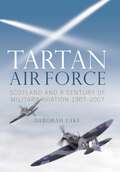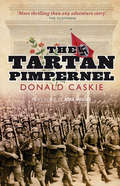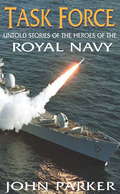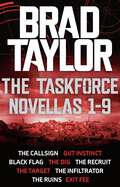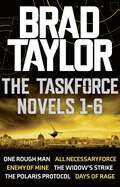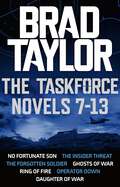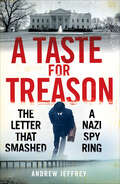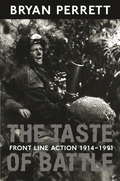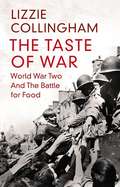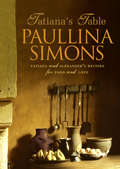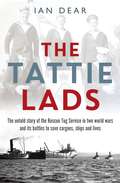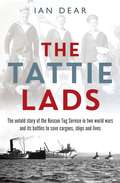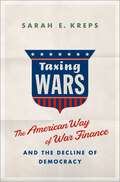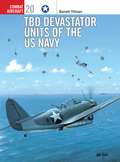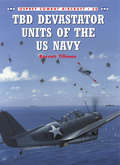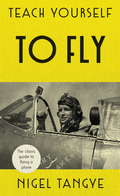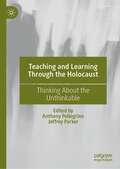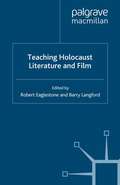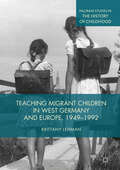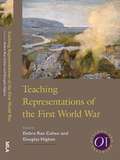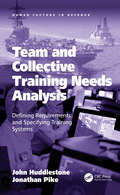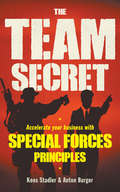- Table View
- List View
Tartan Airforce: Scotland and a Century of Military Aviation 1907-2007
by Deborah LakeBritain's first flying machine was trailed in Perthshire in 1907 and ever since - whether at war or in peacetime - Scotland has been in the frontline of British military aviation. In "Tartan Air Force", Deborah Lake investigates Scotland's contribution to military flying over the last hundred years. With a wealth of previously unpublished or little-known accounts from air and ground crew, fliers and non-fliers, this is a comprehensive and entertaining tribute which emphasises the human aspect of Scotland's part in the history. From the Second World War, when many famous missions, including those against the great German battleship Tirpitz, were undertaken from Scottish airfields, to the importance of its RAF air bases and radar stations in asserting the Soviet threat during the Cold War and beyond, Scotland has played its part in protecting the skies.
The Tartan Pimpernel
by Donald Caskie Caskie Donald Caskie, was born at Bowmore, Islay in 1902Donald Caskie was a minister of the Scots Kirk in Paris at the time of German invasion of France in 1940. Although he had the opportunity to flee, Caskie stayed behind to help establish a network of safe houses and escape routes for allied soldiers and airmen trapped in occupied territory. He was finally sentenced to death at a Nazi show-trial.
Task Force: The Inside Story Of The Ships And Heroes Of The Royal Navy
by John ParkerThe Royal Navy at the start of the twenty-first century had undergone the most remarkable transformation. The Fleet is today the smallest since the start of the Napoleonic wars as surface vessels are no longer viable as a principal line of defence. That preserve is now in the hands of Britain's nuclear-armed submarine fleet, well chronicled in THE SILENT SERVICE and the Air Force, as outlined in STRIKE COMMAND. This book will complete the triangle of our essential military might, telling the story of today's sea-going ultra-mobile, rapid reaction, missile- and aircraft-carrying task force. John Parker includes personal interviews from the men and women who have served in the Senior Service to bring his story vividly to life.
Taskforce Novellas 1-9 Boxset: gripping novellas from ex-Special Forces Commander Brad Taylor
by Brad Taylor'[Taylor] has the gun metal ring of authenticity and the crisp writing of a military communique' NELSON DeMILLE 'Fresh plot, great actions, and Taylor clearly knows what he is writing about... When it comes to tactics and hardware he is spot-on' VINCE FLYNN 'Few authors write about espionage, terrorism, and clandestine hit squads as well as Taylor does' HOUSTON PRESS Threats never cease; the Taskforce never rests. Designed to operate outside the bounds of law, trained to exist on the ragged edge of human capability, the Taskforce's existence is as essential as it is illegal. Recruited from the top operators in the intelligence and special forces spheres, they are led by ex-Special Forces Operator Pike Logan and his protégé, academic turned skilled operator, Jennifer Cahill.Collected in a single volume for the first time, these nine novellas explore the Taskforce from its inception to modern-day missions: THE CALLSIGN. GUT INSTINCT. BLACK FLAG. THE DIG. THE RECRUIT. THE TARGET. THE INFILTRATOR. THE RUINS. EXIT FEE.
Taskforce Novels 1-6 Boxset: gripping novels from ex-Special Forces Commander Brad Taylor
by Brad Taylor'Fresh plot, great actions, and Taylor clearly knows what he is writing about' VINCE FLYNN They're the US Government's secret weapon. They call them the Taskforce. Designed to operate outside the bounds of law, trained to exist on the ragged edge of human capability, their existence is as essential as it is illegal. Recruited from the top operators in the intelligence and special forces spheres, they are led by ex-Special Forces Operator Pike Logan and his protégé, academic turned skilled operator, Jennifer Cahill.Threats never cease; the Taskforce never rests. Written by an ex-special forces operator, the Taskforce books are contemporary, realistic and authentic. On a global stage, the Taskforce team must counter cyber-threats, bio-weapons, assassins, rogue operators, narcotic cartels, coups, kidnappers and political conspiracies.Collected in a single volume for the first time, read the first six Taskforce novels:ONE ROUGH MAN The Taskforce reinstates their dismissed operator, Pike Logan, with one chance to redeem himself: find an unknown enemy, with an unknown target in an unknown location.ALL NECESSARY FORCE The Taskforce faces an impossible decision: how to prevent a bomb detonating in the US, the one country it cannot operate in.ENEMY OF MINE Unless the Taskforce eliminates a professional killer, the American envoy responsible for a treaty between Israel and Palestine will be assassinated.THE WIDOW'S STRIKE The Taskforce confronts the Black Widows – female suicide terrorists – in Thailand, who threaten to unleash a genetically manipulated virus.THE POLARIS PROTOCOL The Taskforce infiltrates a Mexican drug cartel who are exploiting a GPS hack capable of bringing the world to a standstill.DAYS OF RAGE The Taskforce must neutralise a weapon of mass destruction that Russia has supplied to Islamic fundamentalists.Praise for Brad Taylor: 'It's an excellent read, and I greatly enjoyed it' NELSON DeMILLE'Pike ranks right up there with Jason Bourne, Jack Reacher and Jack Bauer' JOHN LESCROART'Logan is a tough, appealing hero you're sure to root for' JOSEPH FINDER
Taskforce Novels 7-13 Boxset: gripping novels from ex-Special Forces Commander Brad Taylor
by Brad Taylor'[Taylor] has the gun metal ring of authenticity and the crisp writing of a military communique' NELSON DeMILLE They're the US Government's secret weapon. They call them the Taskforce. Designed to operate outside the bounds of law, trained to exist on the ragged edge of human capability, their existence is as essential as it is illegal. Recruited from the top operators in the intelligence and special forces spheres, they are led by ex-Special Forces Operator Pike Logan and his protégé, academic turned skilled operator, Jennifer Cahill.Threats never cease; the Taskforce never rests. Written by an ex-special forces operator, the Taskforce books are contemporary, realistic and authentic. On a global stage, the Taskforce team must counter cyber-threats, bio-weapons, assassins, rogue operators, narcotic cartels, coups, kidnappers and political conspiracies.Collected in a single volume for the first time, read the next seven Taskforce novels:NO FORTUNATE SON The Taskforce faces an ultimatum: cease all counter-terrorist operations or hostages – abducted relatives of the US political elite – will be killed one by one.THE INSIDER THREAT While world powers combat ISIS on the battlefield, the Taskforce must counter an ingenious new threat from the organization – one that can't be defeated by an airstrike.THE FORGOTTEN SOLDIER The Taskforce face their most dangerous threat yet: a Taskforce Operator gone rogue.GHOSTS OF WAR As tensions rise on the fault lines of the old Iron Curtain, the Taskforce must unravel a plot to force a lethal confrontation between NATO and Russia.RING OF FIRE The Panama Papers leak puts the Taskforce on the trail of a plot to cause unimaginable destruction across the United States... a plot that's already in motion.OPERATOR DOWN The Taskforce's search for a missing Mossad agent puts them on a collision course with a ruthless military coup in Africa.DAUGHTER OF WAR A young refugee holds the key to an international conspiracy. The Taskforce needs to find her before the Syrians or North Koreans do.Praise for Brad Taylor: 'Fresh plot, great actions, and Taylor clearly knows what he is writing about' VINCE FLYNN'Pike ranks right up there with Jason Bourne, Jack Reacher and Jack Bauer' JOHN LESCROART'Logan is a tough, appealing hero you're sure to root for' JOSEPH FINDER
A Taste for Treason: The Letter That Smashed a Nazi Spy Ring
by Andrew JeffreyA gripping true story of wartime espionage. Dundee, 1937. When housewife Mary Curran became suspicious of hairdresser Jessie Jordan's frequent trips to Nazi Germany, she had no idea that she was about to be drawn into an international web of espionage. Thanks to a tip off from Mary, MI5 and the FBI launched major spy hunts on both sides of the Atlantic. This is the true story of a decade-long series of Nazi espionage plots in Britain, Europe and the United States. It shows how a Nazi spy's letter, posted in New York and intercepted in Scotland, broke spy rings across Europe and North America. And it reveals, for the first time, how that letter marked the genesis of an intelligence and security alliance that today includes the United States, the UK, Canada, Australia and New Zealand. 'Fascinating, gripping and expertly researched... an extraordinary true tale of espionage told with all the drama and panache of a spy thriller' – Michael Smith, bestselling author of The Secrets of Station X
The Taste Of Battle: Front Line Action 1914-1991 (Cassell Military Paperbacks Ser.)
by Bryan PerrettAs close as you can get to the reality of war. Three generations of front line soldiers recount their experiences.Few people today experience a live war situation; even professional soldiers can serve their career without going to war. Yet the question is often asked, what is it like? How do combatants cope with the danger? How does a battle look to the ordinary soldier?In a unique mix of dialogue, reportage and objective historical analysis - "faction" - Bryan Perrett brings the reality of war to the reader in a direct, no-holds-barred, exciting narrative. The fictional soldiers in this book, based on recorded accounts, are at the very heart of the action. From Mons in 1918, through the First and Second World Wars to Malaya in 1956, Vietnam in 1968 and Kuwait in 1991.
The Taste of War: World War Two and the Battle for Food
by Lizzie CollinghamFood, and in particular the lack of it, was central to the experience of the Second World War. In this richly detailed and engaging history, Lizzie Collingham establishes how control of food and its production is crucial to total war. How were the imperial ambitions of Germany and Japan - ambitions which sowed the seeds of war - informed by a desire for self-sufficiency in food production? How was the outcome of the war affected by the decisions that the Allies and the Axis took over how to feed their troops? And how did the distinctive ideologies of the different combatant countries determine their attitudes towards those they had to feed?Tracing the interaction between food and strategy, on both the military and home fronts, this wide-ranging, gripping and dazzlingly original account demonstrates how the issue of access to food was a driving force within Nazi policy and contributed to the decision to murder hundreds of thousands of 'useless eaters' in Europe. Focusing on both the winners and losers in the battle for food, this book brings to light the striking fact that war-related hunger and famine was not only caused by Nazi Germany and Imperial Japan, but was also the result of Allied mismanagement and neglect, particularly in India, Africa and China. American dominance both during and after the war was not only a result of the United States' immense industrial production but also of its abundance of food. This book traces the establishment of a global pattern of food production and distribution and shows how the war subsequently promoted the pervasive influence of American food habits and tastes in the post-war world. A work of great scope, The Taste of War connects the broad sweep of history to its intimate impact upon the lives of individuals.
Tatiana and Alexander: Tatiana And Alexander's Life Of Food And Love (The\bronze Horseman Ser. #2)
by Paullina SimonsA powerful story of grief, hope and an epic love, from the Russian-born author of internationally bestselling novels, TULLY and ROAD TO PARADISE.
Tatiana’s Table: Tatiana And Alexander's Life Of Food And Love
by Paullina SimonsLove, passion, food – the essential ingredients in TATIANA’S TABLE, from the bestselling author of THE BRONZE HORSEMAN, THE BRIDGE TO HOLY CROSS and THE SUMMER GARDEN.
The Tattie Lads: The untold story of the Rescue Tug Service in two world wars and its battles to save cargoes, ships and lives
by Ian DearEnduring great danger and often terrible conditions in heavy seas, the Rescue Tug Services worked tirelessly to bring to port damaged vessels and keep up the supply of food and essential items during two world wars.They were first deployed towards the end of the First World War to support and if necessary to salvage merchant shipping that had been damaged by U-boat attacks. During the Second World War they were needed even more urgently when ships bringing food and other essential supplies to a beleaguered Britain were attacked by both air strikes and submarines. Although part of the Royal Navy, the contribution of the Rescue Tug Service remained curiously absent from the naval history of the Second World War. Yet the Service had developed what a wartime American newspaper called 'a new type of naval vessel – the British fighting escort tug' and had saved millions of tons of shipping, both warships and merchant ships, not to mention the crews and the precious cargoes. The official history of the Merchant Navy did not mention the Service either, nor did numerous other books on the war at sea. In 2014 author Ian Dear was given access to the archives of the Deep Sea Rescue Tug Service which were about to be disbanded. His research, here and elsewhere produced a view of the war at sea from an entirely new angle. The result, The 'Tattie Lads' explores why the service might have been omitted from the official story, and reveals its fascinating history in a full-length book for the first time.
The Tattie Lads: The untold story of the Rescue Tug Service in two world wars and its battles to save cargoes, ships and lives
by Ian DearEnduring great danger and often terrible conditions in heavy seas, the Rescue Tug Services worked tirelessly to bring to port damaged vessels and keep up the supply of food and essential items during two world wars.They were first deployed towards the end of the First World War to support and if necessary to salvage merchant shipping that had been damaged by U-boat attacks. During the Second World War they were needed even more urgently when ships bringing food and other essential supplies to a beleaguered Britain were attacked by both air strikes and submarines. Although part of the Royal Navy, the contribution of the Rescue Tug Service remained curiously absent from the naval history of the Second World War. Yet the Service had developed what a wartime American newspaper called 'a new type of naval vessel – the British fighting escort tug' and had saved millions of tons of shipping, both warships and merchant ships, not to mention the crews and the precious cargoes. The official history of the Merchant Navy did not mention the Service either, nor did numerous other books on the war at sea. In 2014 author Ian Dear was given access to the archives of the Deep Sea Rescue Tug Service which were about to be disbanded. His research, here and elsewhere produced a view of the war at sea from an entirely new angle. The result, The 'Tattie Lads' explores why the service might have been omitted from the official story, and reveals its fascinating history in a full-length book for the first time.
Taxing Wars: The American Way of War Finance and the Decline of Democracy
by Sarah KrepsWhy have the wars in Afghanistan and Iraq lasted longer than any others in American history? The conventional wisdom suggests that the move to an all-volunteer force and unmanned technologies such as drones have reduced the apparent burden of war so much that they have allowed these conflicts to continue almost unnoticed for years. Taxing Wars suggests that the burden in blood is just one side of the coin. The way Americans bear the burden in treasure has also changed, and these changes have both eroded accountability and contributed to the phenomenon of perpetual war. Sarah Kreps chronicles the entire history of how America has paid for its wars-and how its methods have changed. Early on, the United States imposed war taxes that both demanded sacrifices from all Americans and served as reminders of their participation. Indeed, thinkers from Immanuel Kant to Adam Smith argued that these reminders were exactly the reason why democracies tended to fight shorter and less costly wars. Bearing these burdens caused the populace to sue for peace when the costs mounted. Leaders in a democracy, responsive to their citizens, would have incentives to heed that opposition and bring wars to as expeditious an end as possible. Since the Korean War, the United States has increasingly moved away from war taxes. Instead, borrowing-and its comparatively less visible connection with the war-has become a permanent feature of contemporary wars. The move serves leaders well because reducing the apparent burden of war has helped mute public opposition and any decision-making constraints. But by masking accountability, however, the move away from war taxes undermines the basis for democratic restraint in wartime. Contemporary wars have become correspondingly longer and costlier as the public has become disconnected from those burdens. Given the trends identified in Taxing Wars, the recent past-epitomized by our lengthy wars in Afghanistan and Iraq-is likely to be prologue.
Taxing Wars: The American Way of War Finance and the Decline of Democracy
by Sarah KrepsWhy have the wars in Afghanistan and Iraq lasted longer than any others in American history? The conventional wisdom suggests that the move to an all-volunteer force and unmanned technologies such as drones have reduced the apparent burden of war so much that they have allowed these conflicts to continue almost unnoticed for years. Taxing Wars suggests that the burden in blood is just one side of the coin. The way Americans bear the burden in treasure has also changed, and these changes have both eroded accountability and contributed to the phenomenon of perpetual war. Sarah Kreps chronicles the entire history of how America has paid for its wars-and how its methods have changed. Early on, the United States imposed war taxes that both demanded sacrifices from all Americans and served as reminders of their participation. Indeed, thinkers from Immanuel Kant to Adam Smith argued that these reminders were exactly the reason why democracies tended to fight shorter and less costly wars. Bearing these burdens caused the populace to sue for peace when the costs mounted. Leaders in a democracy, responsive to their citizens, would have incentives to heed that opposition and bring wars to as expeditious an end as possible. Since the Korean War, the United States has increasingly moved away from war taxes. Instead, borrowing-and its comparatively less visible connection with the war-has become a permanent feature of contemporary wars. The move serves leaders well because reducing the apparent burden of war has helped mute public opposition and any decision-making constraints. But by masking accountability, however, the move away from war taxes undermines the basis for democratic restraint in wartime. Contemporary wars have become correspondingly longer and costlier as the public has become disconnected from those burdens. Given the trends identified in Taxing Wars, the recent past-epitomized by our lengthy wars in Afghanistan and Iraq-is likely to be prologue.
TBD Devastator Units of the US Navy (Combat Aircraft)
by Barrett Tillman Tom TullisThe first monoplane aircraft ordered by the US Navy for carrier operations, the Douglas TBD Devastator was designed to fulfil a requirement for a new torpedo bomber. Just 129 were built, and when it entered service it was the most modern aircraft of its type anywhere in the world. Its only real taste of action came on 4 June 1942 in the pivotal Battle of Midway, when 35 were shot down in a clash with Japanese A6M Zero fighters. The aircraft was replaced by the Grumman Avenger weeks later.
TBD Devastator Units of the US Navy (Combat Aircraft #20)
by Barrett Tillman Tom TullisThe first monoplane aircraft ordered by the US Navy for carrier operations, the Douglas TBD Devastator was designed to fulfil a requirement for a new torpedo bomber. Just 129 were built, and when it entered service it was the most modern aircraft of its type anywhere in the world. Its only real taste of action came on 4 June 1942 in the pivotal Battle of Midway, when 35 were shot down in a clash with Japanese A6M Zero fighters. The aircraft was replaced by the Grumman Avenger weeks later.
Teach Yourself to Fly: The classic guide to flying a plane
by Nigel TangyeFirst published in 1938, Teach Yourself To Fly was not only one of the very first Teach Yourself books to be published but the first to actually change the world. It was used on the eve of the second world war to prepare pilot recruits and conscripts before they were called for service, and as such it was read religiously by thousands of young men, some as young as 17, and directly impacted on the British war effort.This beautiful new printing of the book captures all of the feelings of that extraordinary time - it's nostalgic, understated, inspiring and very British indeed, warning young pilots, amongst other things, not to feel 'too discouraged' in the event of a crash landing.Technology has changed hugely, but the principles of aviation as they were in the middle of the twentieth century are perfectly summarised in this lovely book. Get hold of the right vehicle, and it really can teach you to fly. What happens when you're up there, however, is your responsibility.Since 1938, millions of people have learned to do the things they love with Teach Yourself. Welcome to the how-to guides that changed the modern world.
Teaching and Learning Through the Holocaust: Thinking About the Unthinkable
by Anthony Pellegrino Jeffrey ParkerThis book serves as a critical resource for educators across various roles and contexts who are interested in Holocaust education that is both historically sound and practically relevant. As a collection, it pulls together a diverse group of scholars to share their research and experiences. The volume endeavors to address topics including the nature and purpose of Holocaust education, how our understanding of the Holocaust has changed, and resources we can use with learners. These themes are consistent across the chapters, making for a comprehensive exploration of learning through the Holocaust today and in the future.
Teaching Holocaust Literature and Film (Teaching the New English)
by R. Eaglestone B. LangfordThe representation of the Holocaust in literature and film has confronted lecturers and students with some challenging questions. Does this unique and disturbing subject demand alternative pedagogic strategies? What is the role of ethics in the classroom encounter with the Holocaust? Scholars address these and other questions in this collection.
Teaching Migrant Children in West Germany and Europe, 1949–1992 (Palgrave Studies in the History of Childhood)
by Brittany LehmanThis book examines the right to education for migrant children in Europe between 1949 and 1992. Using West Germany as a case study to explore European trends, the book analyzes how the Council of Europe and European Community’s ideological goals were implemented for specific national groups. The book starts with education for displaced persons and exiles in the 1950s, then compares schooling for Italian, Greek, and Turkish labor migrants, then circles back to asylum seekers and returning ethnic Germans. For each group, the state entries involved tried to balance equal education opportunities with the right to personhood, an effort which became particularly convoluted due to implicit biases. When the European Union was founded in 1993, children’s access to education depended on a complicated mix of legal status and perception of cultural compatibility. Despite claims that all children should have equal opportunities, children’s access was limited by citizenship and ethnic identity.
Teaching Representations Of The First World War (PDF)
by Debra Rae Cohen Douglas HigbeeThe First World War saw staggering loss of life and was a catalyst for many political and social changes. It was also shaped by the media and art forms that expressed it: film, photography, poetry, memoir, posters, advertisements, and music. This volume's scope shows that today's instructors contend with many different issues in teaching the First World War in a variety of classroom settings. Among these issues are the war's relation to modernism; global reach in the Middle East and South Asia; influence on psychiatry, pacifism, and consumer culture; and effect on public health and the 1918 influenza pandemic.
Team and Collective Training Needs Analysis: Defining Requirements and Specifying Training Systems (Human Factors in Defence)
by John Huddlestone Jonathan PikeMilitary capability is delivered operationally at a team and collective level, be it a unit as small as a squad or section, or as large as a maritime task group. Modern military forces are required to deal with a potentially wide range of missions frequently involving multiple alliance partners, within a geopolitical environment which can seem to change rapidly. Individual performance, while being important, is not the primary determinant of mission success - force integration, interoperability, adaptability and teamwork are key factors. Team and collective training which fully addresses these factors is fundamental to the development and delivery of military capability. As a consequence, the requirement to determine training requirements and specify effective systems for the delivery of team and collective training is critical to operational success. Training Needs Analysis (also known as Front End Analysis), is a well-established methodology for analysing training requirements and specifying training solutions used extensively by the UK and its NATO partners. However, the analytical techniques employed are optimised for individual training, with little guidance being offered on its application in the team and collective context. Team and Collective Training Needs Analysis (TCTNA) has been developed to close this methodological gap. It addresses the issues of the relationship of individual and team tasks, teamwork, command and control, task and training environments, scenario definition, instructional strategy, team training approaches, instructional functions, and wide-ranging organisational and procurement considerations. Part One of the book develops an integrated set of models which underpin the analytical approach presented in Part Two. Worked examples and case studies illustrate the application of the approach. Between 2005 and 2015 the authors worked on numerous training-related research projects at Cranfield University and Coventry University for the Human Factors Integration Defence Technology Centre and the Defence Human Capability Science and Technology Centre on behalf of the Defence Science and Technology Laboratory, UK Ministry of Defence.
Team and Collective Training Needs Analysis: Defining Requirements and Specifying Training Systems (Human Factors in Defence)
by John Huddlestone Jonathan PikeMilitary capability is delivered operationally at a team and collective level, be it a unit as small as a squad or section, or as large as a maritime task group. Modern military forces are required to deal with a potentially wide range of missions frequently involving multiple alliance partners, within a geopolitical environment which can seem to change rapidly. Individual performance, while being important, is not the primary determinant of mission success - force integration, interoperability, adaptability and teamwork are key factors. Team and collective training which fully addresses these factors is fundamental to the development and delivery of military capability. As a consequence, the requirement to determine training requirements and specify effective systems for the delivery of team and collective training is critical to operational success. Training Needs Analysis (also known as Front End Analysis), is a well-established methodology for analysing training requirements and specifying training solutions used extensively by the UK and its NATO partners. However, the analytical techniques employed are optimised for individual training, with little guidance being offered on its application in the team and collective context. Team and Collective Training Needs Analysis (TCTNA) has been developed to close this methodological gap. It addresses the issues of the relationship of individual and team tasks, teamwork, command and control, task and training environments, scenario definition, instructional strategy, team training approaches, instructional functions, and wide-ranging organisational and procurement considerations. Part One of the book develops an integrated set of models which underpin the analytical approach presented in Part Two. Worked examples and case studies illustrate the application of the approach. Between 2005 and 2015 the authors worked on numerous training-related research projects at Cranfield University and Coventry University for the Human Factors Integration Defence Technology Centre and the Defence Human Capability Science and Technology Centre on behalf of the Defence Science and Technology Laboratory, UK Ministry of Defence.
The Team Secret: Accelerate your Business with Special Forces Principles
by Koos Stadler Anton BergerThe South African Special Forces achieved exceptional results with small groups of elite soldiers instead of larger, conventional teams. The Team Secret shows that the same principle applies in the business world – a small team has a much better chance of completing projects efficiently, on budget and on time.Teams, rather than individuals, form the DNA of many companies and they play a pivotal role in achieving strategic and financial success. Like Special Forces teams, they must function as a well-oiled machine firing on all cylinders.Koos Stadler tells in captivating detail about a real-life Special Forces operation and the lessons learnt about team dynamics and achieving the goal. His story, combined with anecdotes from Anton Burger’s experiences as a team leader in different work environments, show the many lessons the business world can take from the Special Forces.The book identifies the key characteristics of an effective team, how to select the right team members, how to inculcate an ethos centred around team principles and how an effective team should be led. It speaks to both team members and team leaders across all managerial levels – from a team leader in a call centre to a project manager or CEO.In short: To fast-track your business, shape up your teams!
